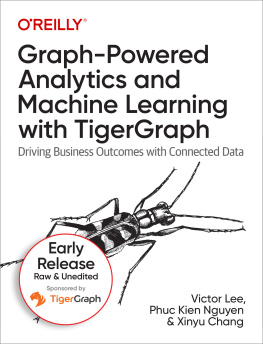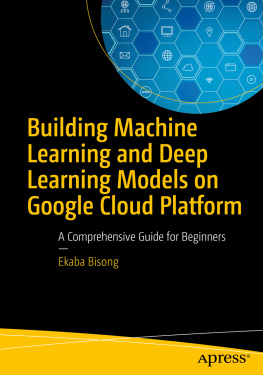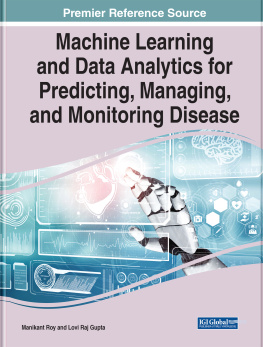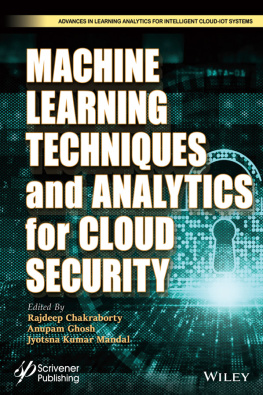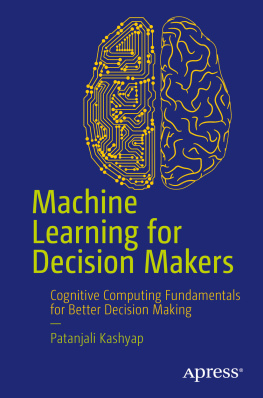Mohanty Sachi Nandan - Machine Learning Approach for Cloud Data Analytics in IoT
Here you can read online Mohanty Sachi Nandan - Machine Learning Approach for Cloud Data Analytics in IoT full text of the book (entire story) in english for free. Download pdf and epub, get meaning, cover and reviews about this ebook. year: 2021, publisher: Wiley, genre: Home and family. Description of the work, (preface) as well as reviews are available. Best literature library LitArk.com created for fans of good reading and offers a wide selection of genres:
Romance novel
Science fiction
Adventure
Detective
Science
History
Home and family
Prose
Art
Politics
Computer
Non-fiction
Religion
Business
Children
Humor
Choose a favorite category and find really read worthwhile books. Enjoy immersion in the world of imagination, feel the emotions of the characters or learn something new for yourself, make an fascinating discovery.
- Book:Machine Learning Approach for Cloud Data Analytics in IoT
- Author:
- Publisher:Wiley
- Genre:
- Year:2021
- Rating:3 / 5
- Favourites:Add to favourites
- Your mark:
- 60
- 1
- 2
- 3
- 4
- 5
Machine Learning Approach for Cloud Data Analytics in IoT: summary, description and annotation
We offer to read an annotation, description, summary or preface (depends on what the author of the book "Machine Learning Approach for Cloud Data Analytics in IoT" wrote himself). If you haven't found the necessary information about the book — write in the comments, we will try to find it.
Machine Learning Approach for Cloud Data Analytics in IoT — read online for free the complete book (whole text) full work
Below is the text of the book, divided by pages. System saving the place of the last page read, allows you to conveniently read the book "Machine Learning Approach for Cloud Data Analytics in IoT" online for free, without having to search again every time where you left off. Put a bookmark, and you can go to the page where you finished reading at any time.
Font size:
Interval:
Bookmark:

Scrivener Publishing
100 Cummings Center, Suite 541J
Beverly, MA 01915-6106
Publishers at Scrivener
Martin Scrivener ()
Phillip Carmical ()
Edited by
Sachi Nandan Mohanty
Jyotir Moy Chatterjee
Monika Mangla
Suneeta Satpathy
Sirisha Potluri

This edition first published 2021 by John Wiley & Sons, Inc., 111 River Street, Hoboken, NJ 07030, USA and Scrivener Publishing LLC, 100 Cummings Center, Suite 541J, Beverly, MA 01915, USA
2021 Scrivener Publishing LLC
For more information about Scrivener publications please visit www.scrivenerpublishing.com.
All rights reserved. No part of this publication may be reproduced, stored in a retrieval system, or transmitted, in any form or by any means, electronic, mechanical, photocopying, recording, or otherwise, except as permitted by law. Advice on how to obtain permission to reuse material from this title is available at http://www.wiley.com/go/permissions.
Wiley Global Headquarters
111 River Street, Hoboken, NJ 07030, USA
For details of our global editorial offices, customer services, and more information about Wiley products visit us at www.wiley.com.
Limit of Liability/Disclaimer of Warranty
While the publisher and authors have used their best efforts in preparing this work, they make no representations or warranties with respect to the accuracy or completeness of the contents of this work and specifically disclaim all warranties, including without limitation any implied warranties of merchantability or fitness for a particular purpose. No warranty may be created or extended by sales representatives, written sales materials, or promotional statements for this work. The fact that an organization, website, or product is referred to in this work as a citation and/or potential source of further information does not mean that the publisher and authors endorse the information or services the organization, website, or product may provide or recommendations it may make. This work is sold with the understanding that the publisher is not engaged in rendering professional services. The advice and strategies contained herein may not be suitable for your situation. You should consult with a specialist where appropriate. Neither the publisher nor authors shall be liable for any loss of profit or any other commercial damages, including but not limited to special, incidental, consequential, or other damages. Further, readers should be aware that websites listed in this work may have changed or disappeared between when this work was written and when it is read.
Library of Congress Cataloging-in-Publication Data
ISBN 978-1-119-78580-4
Cover image: Pixabay.Com
Cover design by Russell Richardson
Set in size of 11pt and Minion Pro by Manila Typesetting Company, Makati, Philippines
Printed in the USA
10 9 8 7 6 5 4 3 2 1
Sustainable computing paradigms like cloud and fog are capable of handling issues related to performance, storage and processing, maintenance, security, efficiency, integration, cost, energy and latency in an expeditious manner. According to statistics, billions of connected IoT devices will be producing enormous amounts of real-time data in the coming days. In order to expedite decision-making involved in the complex computation and processing of collected data, these devices are connected to the cloud or fog environment. Since machine learning as a service provides the best support in business intelligence, organizations have been making significant investments in the creation of the first artificial intelligence services. The abundant research occurring all around the world has resulted in a wide range of advancements being reported on computing platforms. This book elucidates some of the best practices and their respective outcomes in cloud and fog computing environments. The practices, technologies and innovations of business intelligence employed to make expeditious decisions are encouraged as a part of this area of research.
This book focuses on various research issues related to big data storage and analysis, large-scale data processing, knowledge discovery and knowledge management, computational intelligence, data security and privacy, data representation and visualization and data analytics. The featured technology presented herein optimizes various industry processes using business intelligence in engineering and technology. Light is also shed on cloud-based embedded software development practices to integrate complex machines so as to increase productivity and reduce operational cost. The various practices of data science and analytics which are used in all sectors to understand big data and analyze massive data patterns are also essential sections of this book.
explores the anthropomorphic gamifying elements, mostly on how it can be implemented in a blockchain-enabled transitional healthcare system in a more lucrative manner.
Sachi Nandan Mohanty, India
Jyotir Moy Chatterjee, Nepal
Monika Mangla, India
SuneetaSatpathy, India
Sirisha Potluri, India
May 2021
The editors would like to pass on our good wishes and express our appreciation to all the authors who contributed chapters to this book. We would also like to thank the subject matter experts who found time to review the chapters and deliver their comments in a timely manner. Special thanks also go to those who took the time to give advice and make suggestions that helped refine our thoughts and approaches accordingly to produce richer contributions. We are particularly grateful to Scrivener Publishing for their amazing crew who supported us with their encouragement, engagement, support, cooperation and contributions in publishing this book.
Machine LearningBased Data Analysis
M. Deepika
Department of Computer Science, School of Computing Sciences, Vels Institute of Science, Technology and Advanced Studies (Formerly Vels University), Chennai, Tamil Nadu, India
Department of Computer Applications, School of Computing Sciences, Vels Institute of Science, Technology and Advanced Studies (Formerly Vels University), Chennai, Tamil Nadu, India
Abstract
Artificial intelligence (AI) is a technical mix, and machine learning (ML) is one of the most important techniques in highly personalized marketing. AI ML presupposes that the system is re-assessed and the data is reassessed without human intervention. It is all about shifting. Just as AI means, for every possible action/reaction, that a human programmer does not have to code, AI machine programming can evaluate and test data to replicate every customer product with the speed and capacity that no one can attain. The technology we have been using has been around for a long time, but the influence of machines, cloud-based services, and the applicability of AI on our position as marketers have changed in recent years. Different information and data orientation contribute to a variety of technical improvements. This chapter focuses on the use of large amounts of information that enables a computer to carry out a non-definitive analysis based on project understanding. It also focuses on data collection and helps to ensure that data analysis is prepared. It also defines such data analytics processes for prediction and analysis using ML algorithms. Questions related to ML data mining are also clearly explained.
Next pageFont size:
Interval:
Bookmark:
Similar books «Machine Learning Approach for Cloud Data Analytics in IoT»
Look at similar books to Machine Learning Approach for Cloud Data Analytics in IoT. We have selected literature similar in name and meaning in the hope of providing readers with more options to find new, interesting, not yet read works.
Discussion, reviews of the book Machine Learning Approach for Cloud Data Analytics in IoT and just readers' own opinions. Leave your comments, write what you think about the work, its meaning or the main characters. Specify what exactly you liked and what you didn't like, and why you think so.




